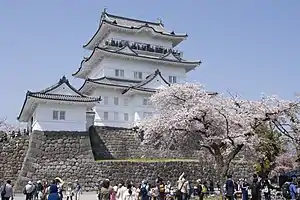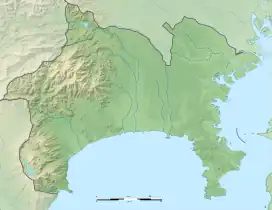| Third Siege of Odawara | |||||||
|---|---|---|---|---|---|---|---|
| Part of the Sengoku period | |||||||
 Later Hōjō era`s Odawara Castle | |||||||
| |||||||
| Belligerents | |||||||
|
|
| ||||||
| Commanders and leaders | |||||||
|
Toyotomi Hideyoshi Tokugawa Ieyasu Oda Nobukatsu Maeda Toshiie Uesugi Kagekatsu Honda Tadakatsu Sakai Ietsugu Kobayakawa Takakage Ikoma Chikamasa Horio Yoshiharu Gamō Ujisato Sanada Masayuki Ukita Hideie Hosokawa Tadaoki Kuroda Kanbei Ii Naomasa Hori Hidemasa Mogami Yoshiaki Sanada Yukimura |
Hōjō Ujimasa † Hōjō Ujiteru † Hōjō Ujikuni Hōjō Ujinao Hōjō Ujitada Hōjō Ujimitsu Hōjō Ujitaka Chiba Naoshige Matsuda Norihide Narita Ujinaga Daidōji Masashige Fūma Kotarō | ||||||
| Strength | |||||||
|
Army of the Tōkaidō: 170,000 Army of the Tōsandō: 35,000 Navy: 10,000–20,630 220,000 total | 82,000 total | ||||||
 Location within Kanagawa Prefecture  Siege of Odawara (1590) (Japan) | |||||||
The third Siege of Odawara (小田原征伐, Odawara seibatsu) occurred in 1590, and was the primary action in Toyotomi Hideyoshi's campaign to eliminate the Hōjō clan as a threat to his power. The months leading up to it saw hasty but major improvements in the defense of the castle, as Hideyoshi's intentions became clear. Thus, despite the overwhelming force brought to bear by Hideyoshi, the siege saw little actual fighting.
Background
In 1588, Toyotomi Hideyoshi succeeded in re-unifying the nation, after several campaigns following the death of Oda Nobunaga in 1582. Hideyoshi asked Hōjō Ujimasa and Ujinao (father and son), to attend the imperial visit to Jurakudai (Hideyoshi's residence and office in Kyoto), but Ujimasa refused. However, Ujimasa proposed to reschedule the visit to spring or summer of 1590, but Hideyoshi in turn refused the proposal, which worsened their relationship. In May 1590, Hideyoshi launched the Odawara Campaign against Hōjō.
The siege
The massive army of Toyotomi Hideyoshi surrounded the castle in what has been called "the most unconventional siege lines in samurai history." The samurai were entertained by everything from concubines, prostitutes, and musicians to acrobats, fire-eaters, and jugglers. The defenders slept on the ramparts with their arquebuses and armor; despite their smaller numbers, they discouraged Hideyoshi from attacking. So, for the most part, this siege consisted of traditional starvation tactics. Only a few small skirmishes erupted around the castle, as when a group of miners from Kai Province dug under the castle walls, allowing men under Ii Naomasa to enter.[1] After three months, the sudden appearance of Ishigakiyama Ichiya Castle took away the Hōjō defenders' will to resist and they surrendered.[2]
In addition to taking Odawara Castle, Hideyoshi also defeated the Hōjō at their outposts, led by Maeda Toshiie and Uesugi Kagekatsu this army captured the Hōjō strongholds one-by-one: Matsuida Castle, Minowa Castle, Maebashi Castle, Matsuyama Castle and Hachigata castle before finally arriving at Hachiōji Castle, and Shizuoka in and near the southwestern part of the Kantō region. Included Shimoda fortress at Ise province led by Chosokabe Motochika, where Hideyoshi's naval forces defeated the Izu suigun.
The Chiba clan, allies of the Hōjō in Shimōsa, also saw Sakura Castle fall to Honda Tadakatsu and Sakai Ietsugu of the Tokugawa army during the campaign. Chiba Shigetane, daimyō of the Chiba, surrendered the castle to the besieging forces on the condition that his clan would not be abolished. While the Chiba were consequently divested of all of their holdings, many of their senior members were taken into service by Tokugawa retainer Ii Naomasa, thanks to aid he had received many years earlier from the clan during the occupation of Takeda Katsuyori's Tsutsujigasaki Castle.[3]
However, at Siege of Oshi castle led by Ishida Mitsunari, the defenders surrendered after hearing word that their lord had been defeated at Odawara.
Aftermath
Hōjō Ujimasa failed to hold Odawara against the forces of Toyotomi Hideyoshi and finally Odawara was taken. Later, Ujimasa was forced to commit suicide along with his brother Ujiteru.[4]
Tokugawa Ieyasu, one of Hideyoshi's top generals, was given the Hōjō lands. Though Hideyoshi could not have guessed it at the time, this would turn out to be a great stepping-stone towards Tokugawa's attempts at conquest and the office of shogun.
The tea master Yamanoue Sōji was at the service of the Odawara lords. He was sentenced to death by torture.
In popular culture
The siege of Odawara is the climax of Hideyoshi's story in the video game Samurai Warriors 2. Due to the sheer size of Odawara Castle in the game, it is divided into two stages, the eastern side besieged by the Tokugawa, Chōsokabe (in Xtreme Legends only), Shimazu, and Date armies, and the western side besieged by the Toyotomi main army.
In the Sengoku Basara Season 2 anime, Odawara Castle was the setting for the fight between Toyotomi Hideyoshi and Date Masamune. Hideyoshi was killed in the castle at Masamune's hands. Afterward, Ishida Mitsunari went to the castle to grieve his master's demise.
References
- ↑ Turnbull, Stephen (1998). The Samurai Sourcebook. London: Cassell & Co. p. 241. ISBN 9781854095237.
- ↑ "石垣山一夜城歴史公園" (in Japanese). 小田原観光. Retrieved 9 August 2019.
- ↑ Chiba-ki, Takayama Kiyotaka
- ↑ "Hojo Ujimasa". kotobank. Retrieved 18 October 2021.
- Sansom, George (1961). A History of Japan: 1334–1615. Stanford: Stanford University Press.
- Takayama, Kiyotaka (1893). Chiba-ki (千葉記). Tokyo: Keizai Zasshisha.